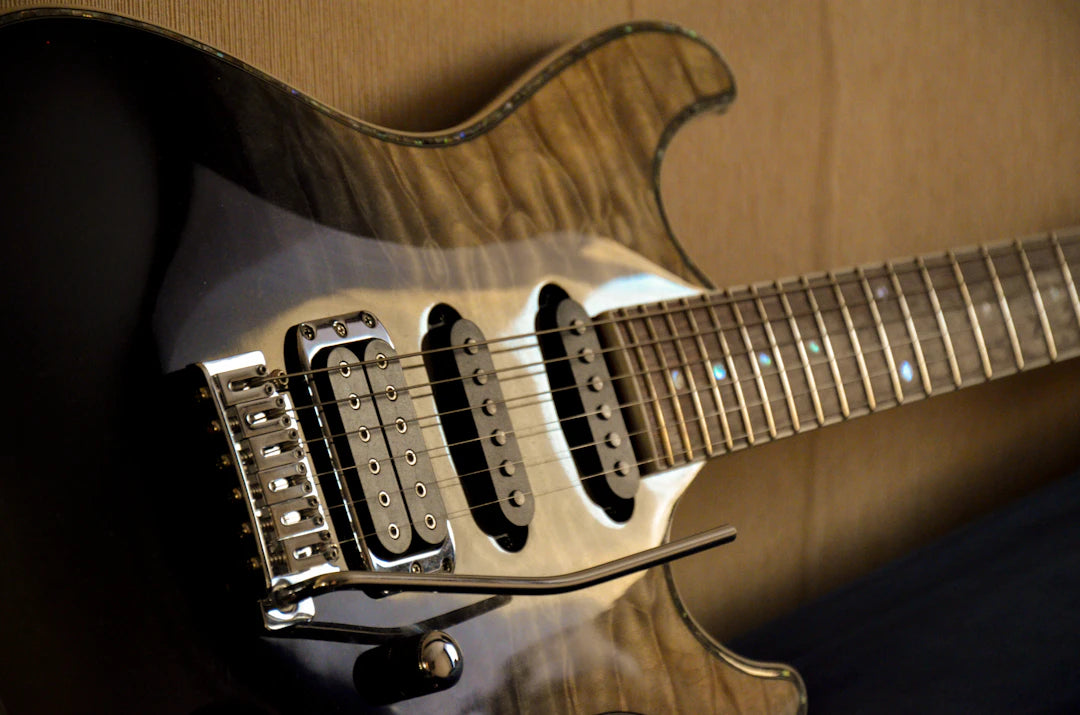Overview
This blog article compares passive and active guitar pickups, outlining their characteristics, advantages, and suitability for different music genres. Passive pickups are known for their warm, dynamic sound and simplicity, making them popular in blues and classic rock. In contrast, active pickups offer higher output and noise reduction, favored in heavy metal and modern rock. The article also discusses installation differences, emphasizes the importance of trying both types before making a decision, and encourages readers to choose based on their personal style and genre preferences.
Frequently Asked Questions
1. What are the main differences between passive and active guitar pickups?
2. Which genres typically favor passive pickups?
3. What advantages do active pickups offer?
4. How does the installation process differ for passive and active pickups?
5. Is it necessary to try both pickup types before making a decision?
Every guitarist, whether a beginner or a seasoned player, understands that the sound quality of an electric guitar largely depends on its pickups. The debate surrounding passive vs. active guitar pickups has been as enduring as the instrument itself. As you consider upgrading your sound, particularly for projects like a Stratocaster sound upgrade, understanding these differences can significantly impact your tone, performance, and overall enjoyment of playing. This extensive guide aims to shed light on both types of pickups to help you make an informed decision for your sound journey.
The Basics of Guitar Pickups
Before diving into the comparison, let's clarify what guitar pickups are and their role in your instrument. Essentially, pickups are electromagnetic devices that convert the vibrations of the guitar strings into electrical signals, which are then amplified to create sound. There are two main categories of guitar pickups: passive and active.
Understanding Passive Guitar Pickups
Passive guitar pickups have been the industry standard for decades, widely recognized for their traditional sound and simplicity. Their design typically features magnets and coils that naturally generate a weak electrical signal from the vibrations of the strings. The sound produced is often described as warm and dynamic, making passive pickups a favorite among many guitarists.
Characteristics of Passive Pickups
- Simplicity: Passive pickups do not require batteries or external power, making them easy to use and maintain.
- Natural Sound: They produce a full-bodied tone that resonates well with various genres, from rock to blues.
- Dynamic Response: Passive pickups respond organically to playing dynamics, allowing for expressive techniques like bending and vibrato.
- Less Output: Compared to active pickups, the output level of passive pickups is lower, which can result in a more organic feel but may not suit every player’s needs.
Popular Genres that Favor Passive Pickups
Many guitar players in genres like blues, classic rock, and jazz often prefer passive pickups due to their nuanced tone. Whether you’re playing a Fender Stratocaster or a Les Paul, you’ll find a range of passive options that can significantly enhance your sound. Guitar pickups made in America often fall into this category, emphasizing craftsmanship and authenticity.
Exploring Active Guitar Pickups
Active guitar pickups have gained popularity, particularly in the heavy metal and modern rock scenes. These pickups feature built-in preamps that require a power source, usually a 9-volt battery, to operate efficiently. This added complexity can elevate your sound, offering a remarkable clarity and higher output that many players find appealing.
Characteristics of Active Pickups
- Higher Output: Active pickups generate a stronger signal, which can drive your amplifier harder and often results in a pronounced tonal clarity.
- Noise Reduction: Equipped with built-in preamps, active pickups tend to minimize hum and noise, making them suitable for high-gain setups.
- Tonally Versatile: They are known for their consistent sound across various pickups and amplifiers, making them a good fit for modern music genres.
- Complexity: The requirement for a battery adds a layer of complexity and maintenance that may not appeal to all guitarists.
Genres That Embrace Active Pickups
If you're a heavy metal enthusiast or play aggressive styles, active pickups can bring your sound to life. They are favored in hard rock and metal music for their ability to sustain high output levels while retaining clarity and articulation.
Comparing the Sound Characteristics
Your choice between passive and active pickups will largely depend on your musical style and personal preferences. Both offer unique tonal characteristics that can complement different genres and playing techniques.
Dynamic Range
Passive pickups are typically more expressive, allowing for a wide dynamic range. You can hear the nuances of your playing—every note, bend, and mute stands out. In contrast, active pickups deliver a predictable sound, which can provide more consistency especially when using effects and processing.
Tonal Clarity vs. Warmth
Active pickups are often celebrated for their clarity and aggression, making them an excellent option for lead guitarists looking to cut through the mix in a band setting. Conversely, passive pickups impart a warmer tone that many players appreciate, especially in blues and jazz genres.
When to Choose Passive Pickups
If you're looking for a Stratocaster sound upgrade and wish to maintain the traditional character of your guitar, passive pickups are worth considering. They often provide lush tones ideal for clean playing and light overdrive, making them perfect for styles that focus on melody and harmony.
When to Go for Active Pickups
On the other hand, if your main goal is to play high-gain music styles or engage in extensive live performance setups, active pickups might be the way to go. Their ability to reduce noise and provide a bright, punchy sound makes them suitable for hard rock and metal genres.
Installation and Maintenance
One of the practical considerations when choosing between passive and active pickups is the installation process and ongoing maintenance. Passive pickups usually require basic soldering skills for installation, while active pickups entail a more complex setup due to the battery and preamp configuration.
Installation Tips
- For passive pickups, familiarize yourself with wiring diagrams for your specific guitar model.
- For active pickups, remember to connect the battery correctly to avoid damage and make sure to check the battery level regularly, as they can drain over time.
- If you're unsure about the installation process, consider consulting a professional guitar technician to ensure optimal performance.
Try Before You Decide
One effective way to determine which type of pickup is right for you is to try both in a controlled environment. Many music stores offer electric guitars equipped with various pickups that you can test out. Experimenting with different settings and amplifiers can help you gauge the tonal differences and find what resonates with your playing style.
Final Thoughts: Making the Right Choice
Choosing between passive and active guitar pickups ultimately depends on your style, genre preference, and personal taste. Conducting thorough research and possibly embarking on a tonal exploration journey will enable you to make a more informed choice. Regardless of what you choose, enhance your sound and achieve the ultimate tone that makes you enjoy every note.
Linked Product
Odyssey Traditions 1957 Stratocaster Pickup Set
The Odyssey Traditions 1957 Stratocaster Pickup Set offers a blend of vintage tone and modern playability, making it suitable for both passive and active guitar setups. This set is designed to enhance the clarity and responsiveness of your guitar, allowing for a versatile range of sounds that cater to different playing styles. Whether you are looking to replicate classic tones or explore new sonic possibilities, this pickup set can be a valuable addition to your instrument.
View Product










